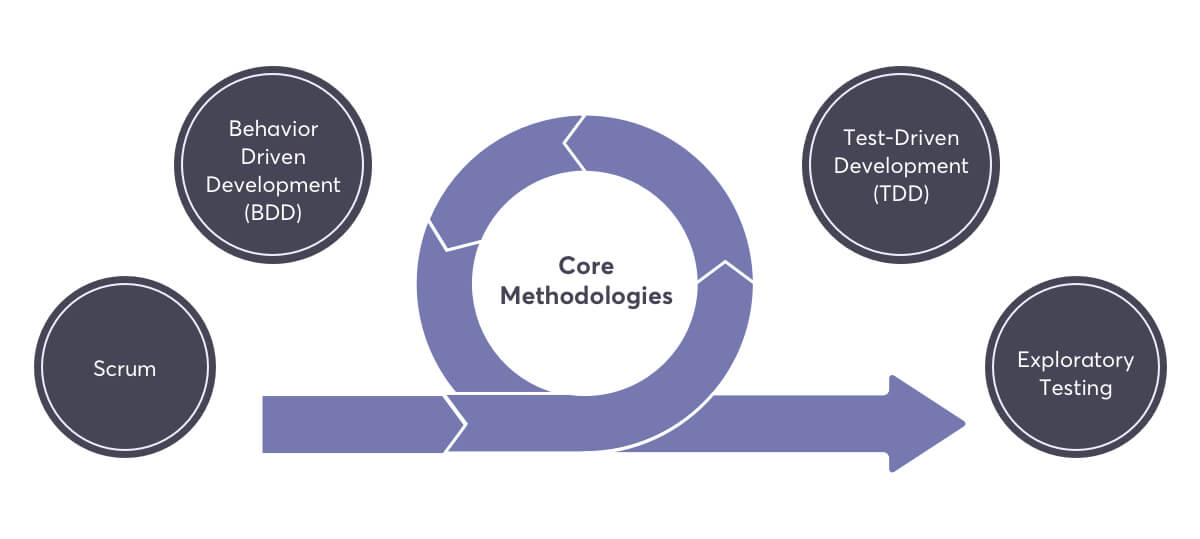Community resources
Community resources
Community resources
Is the Future of Agile Testing Beginning Now?

The results are loud and clear: Quality Assurance (QA) is an integral and inclusive part of agile testing and digital transformation. The recent edition published by World Quality Report mentioned that testing and quality are playing a bigger role in agile and DevOps adoption.
40% of respondents said that one third of their effort goes to testing.
So the simple answer is “The future of agile testing is beginning now as DevOps Testing”
In the last decade, testing has witnessed an unprecedented agile transformation. Continuous integration and delivery (CI/CD), coupled with automated testing, is transforming technology cultures and shortening development cycles. There has been significant improvement in understand and thus adopting testing as integral part, but there are still many organizations trying to figure out where to begin with agile transformation, or how to enable their teams to achieve the goal of quality software at speed.
So what is agile testing ‒ enabler or process?
A collective, fluid, and adaptive approach – agile testing is where testing is consolidated across the whole life-cycle, right from project inception, and involves continuous integration of testing and development processes.
Traditionally, testing remained an independent activity performed after the entire coding was done. On the other hand, agile testing is performed throughout the process. With testers on-boarded between product owners and software developers, an evaluation mechanism is created to help developers code at their best. The target being ‘as fast as possible’, testing needs are prioritized by enlisting them beforehand for avoiding any duplication.
What are the best practices in agile testing?
In agile testing, the following best practices are observed across the industry spectrum:
- On-going Testing: Teams on agile, continuously perform tests to ascertain the product’s progress throughout. Testing is done in parallel with development.
- Regular Feedback: Ongoing feedback is vital for the development team’s progress since they are mandated for a quality check rather than enlisting requirements.
- Testing Performance: Testing is not delegated, rather performed by the entire team formed by testers, developers, and even analysts.
- Enhanced Quality Rating: Cross-functional teams work cohesively to achieve quality of software by testing in every situation. Challenges or improvements are addressed in the same iteration when they are received.
- Minimal Documentation: Checklists are standardized to avoid duplication. Focusing on current requirements warrants wholesome needs.
- Customization: Product owners are partners from the beginning, and during development. Their versions and visions are recorded as stories for easier adaptation, resulting in personalized deliveries.
- Simplicity: Agile testers behave in simple ways to deliver the simplest product, giving the best possible value.
- Swift Response: Versatile in nature, agile testers are adaptable to user’s dynamism, change in the product, or even marketplace.
- Self-organized: Proactively engage every stakeholder to work and re-work on the problem for delivering solutions to everyone’s expectation.
- People-oriented: The key practice is to focus on people rather than technology. So, more interactions, follow-ups, and feedback result in a product with better usability and utility value.
What are the core methodologies in agile testing?

Scrum
A popular agile methodology has the easiest adaptations from the waterfall method, primarily due to its requirement-centric approach that has fewer iterations with frequent collaborations from testers. It demands ongoing touch points across the scrum unit, from stand-ups and sprint reflections, abreast with testing priorities for delivering value in the shortest term.
Test-Driven Development (TDD)
Though organizations are challenged with this reverse methodology, it is most favored for delivering collaborative and effective processes in product development. In TDD, code is formulated for succeeding in an automated unit test. This results in test-inspired documentation ensuring better alignment of deliveries with respect to expectations.
Behavior Driven Development (BDD)
As a subgroup of Test-Driven Development (TDD), Behavior-Driven Development (BDD) gets its requirement initially from the end user’s behavior, unlike technically undergoing unit testing. Though lean by documentation, it weighs heavily on collaboration between tester, developer, and product owner. BDD uses human readable narrative of the software user stories for the test cases. With BDD, tests are created using the gherkin Given-When-Then language.
Interested to know how BDD can help deliver better business outcomes in agile testing?
Learn MoreExploratory Testing
With no boundaries scripted, Exploratory testing has been designed to empower users to carry out testing while they explore websites. This ensures that testers’ time is invested in investigating the site instead of writing every single test activity. Exploratory testing cultivates the culture of flawless communication in the organization. Following an uncharted path with undefined clicks, data entries, or just suspending the process while in action, the testers explore design, execution, and analysis as far as possible from the end-user’s perspective.
Read all about Exploratory testing on Atlassian!
What are the key benefits of agile testing?
As the adoption of agile has grown widely, agile testing has started leaving its imprints in the industry by benefitting software companies.
Increased Interaction: With a focus on people, team, and interactions, there is more personalized delivery with communication happening every time, before and after sprints. A total agile culture is thus reaffirmed in testing.
Continuous Quality Outcome: With testers involved from the starting of the project, time is saved, from early on, by testing with bug detections. In addition, having product owners on board, the entire team perceives their expectations. This results in the refinement of quality.
Quality Software at Speed: Uncompromised quality and delivery ‒ With continuous feedback and sprint mechanisms, development functions are performed on target areas. The result? Optimized software quality vis à vis accelerated delivery.
Bottom line
Having realized the potential agile testing can leverage in your organization, you too can join the agile bandwagon. It is essential to onboard testers who are armed with the right skill-sets and ability to determine the appropriate methodology for implementation. This way, your organization can accelerate savings in terms of cost and time. Debugging or extensions during release will be things of the past. And if you still feel unanswered on agile testing, you are free to reach our agile experts.
Was this helpful?
Thanks!
Disha Thakkar _QMetry_
About this author
Product Marketing, QMetry
QMetry
Ahmedabad, Gujarat, India
1 accepted answer
Atlassian Community Events
- FAQ
- Community Guidelines
- About
- Privacy policy
- Notice at Collection
- Terms of use
- © 2025 Atlassian





1 comment